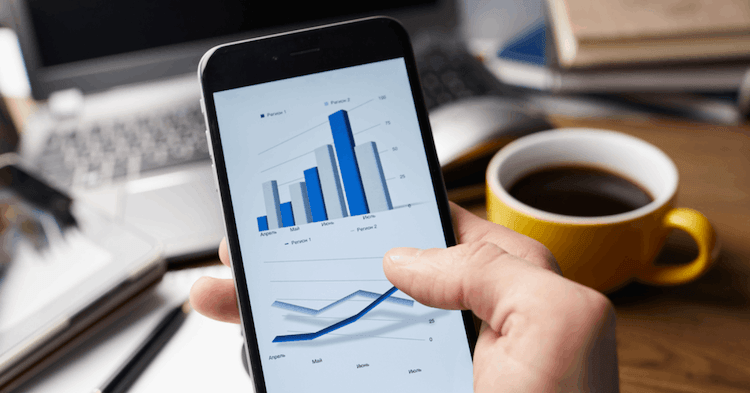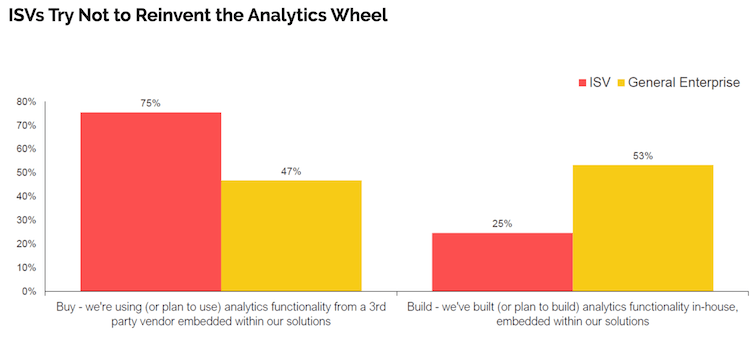With data welcomed as the new oil, analytics capabilities are required for every type of digital product, and mobile apps are no exception. Mobile app analytics give you the information you need to increase the stickiness of your product and to deliver crucial value to app users. Indeed, there’s no longer any question about whether you should use in-app analytics. The only issue remains whether you’re better off buying someone else’s solution, or building out these capabilities on your own.
This “build vs. buy” debate is strong for every area of mobile app development. On the surface level, building your own app components gives you control over every aspect of app functionality, usability and branding. Custom coding also ensures that you have ongoing product support, even if you need to dedicate resources to those efforts, making it easier to predict the expenses you’ll incur.
In contrast, buying your app elements speeds up app creation, is usually less expensive, and enables you to source components that are higher quality than you could create and maintain yourself from scratch, because you’re drawing on the work of experts with years of experience.
The rise of the global embedded analytics market reveals that the tide is turning in the “build vs. buy” debate, and buy has won. The embedded analytics industry is expected to grow as a whole from $26.77 billion in 2017 to $51.78 billion by 2022, with a CAGR of 14.1%. While only 36% of businesses buy their embedded analytics solution today, 53% say that they intend to do so in the near future.
Source: Globenewswire
Let’s take a look at why buying app analytics is the right choice for your mobile app development, and what you should do with that decision.
Ongoing Support Is a Serious Matter
When you build your own analytics solution, you’ll have sole responsibility. This might be good news when it comes to functionality control, but not when it comes to support. You’ll have to invest the time and resources to keep it updated, and respond to customer service requests from app analytics users.
In contrast, when you buy embedded analytics, you get to outsource upkeep and support as well as the initial build process. Aviad Harell, a co-founder of business intelligence software company Sisense, comments that “Top BI vendors provide the professional resources needed to get customers up and running as fast as possible and to address the various maintenance issues that inevitably arise.”
This is significant, since build cost is already a serious concern.
Build Cost is High
Building the backend necessary to support app analytics is extremely costly, averaging around $350,000 but rising quickly if you need to hire new developers, add another UI/UX expert, or retrain your team. Occasionally, if you’re running a small app, the extra build cost could be small enough that it’s worth it for the control you’ll gain, but even then the margin is often narrow.
Fire Up Your Growth!
Moburst propelled leading brands like Google, Reddit, and Uber to the next level. Let’s ignite your Success journey today!
Claim Your FREE Growth Fuel!Buying embedded analytics means that you can slim your team down and save money. “I have seen examples of companies who had 30 developers responsible for building all their visuals on their websites using programming languages and libraries,” notes Gartner analyst Joe Antelmi, “and replaced them with a much smaller team of maybe a couple of people who used embedded analytics platforms.”
Although pricing for embedded analytics can be confusing, you should be able to buy for significantly less than it would cost to build it yourself, and it’s important to remember that money is not the only cost involved.
Time Is Money
Time to market is crucial, but building your own analytics slows you right down. Research by Aberdeen group found that independent software vendors (ISVs), which are more likely to buy embedded analytics, get to market 27% faster on average than other enterprises, which are more likely to build their analytics in-house.
Source: Aberdeen.com
Every decision you make regarding build vs. buy essentially forces you to decide whether you prefer the extra control and customization gained by building your own analytics or the savings you’ll make in time when you buy it off the shelf.
You only have so much time to demonstrate enough growth to justify continuing with your product. The gains involved with slower go-to-market are rarely worth it, especially when you consider everything else that needs your time and attention.
Your Core Product Needs your Attention
Mobile app analytics is a complex beast. To get it right, you need developers who are familiar with the requirements, have mastered many ways to process data, and can dedicate time and energy to the project, as well as UI/UX experts who can create the visualizations that make the data easy for people to process.
Not only does retraining your team cost time and money, it diverts resources away from developing your core product.
That’s a diversion that most companies can’t afford.
“Buying saves time and money over training a development team that may lack previous embedded analytics experience and eliminates the need for training where internal resources are simply not available,” says Casey McGuigan, product manager at Reveal.
Buying Embedded Analytics Isn’t a ‘One and Done’ Decision
While buying an embedded analytics solution is usually the best choice, it’s hardly a once-and-done decision. Sisense’s Harell points out that “The decision to use an external provider for embedding analytics is more similar to a partnership than to a ‘get it and forget it’ type of purchase.” You can’t request the necessary functionality and UX from your provider until you know what your analytics users require and engage with the most, which is dynamic.
The first challenge is to understand what your users want to gain. For example, do they need to see sales data or user interactions, customer satisfaction levels or completed actions? Bear in mind that healthcare providers have different needs from retailers, who have different needs again from finance app owners.
Source: Globenewswire
It’s worthwhile to spend time creating user personas, simulating which questions they’ll ask, and mapping out the tools, metrics and data sources that they’ll need to arrive at useful answers.
You’ll also need to choose which analytics to display and how much data your users will need. Do they need fast access to insights compiled from thousands of data points, or millions? Which will suit them better, high-level data visualizations or advanced, interactive drill-down analytics? Presenting too many charts and dashboards can be overwhelming and push users away, so work out what they really need and resist the temptation to add more.
Buy Is Best for App Analytics, But It’s Not as Simple as You Think
Thanks to offering lower costs, faster time to market, greater professional expertise, and easier external support, the “buy” camp has virtually won the argument over building or buying mobile app analytics. But it’s important to remember that you’ll still need to provide significant input into creation of embedded analytics, working with the provider to create the functionality and design that your users desire, in order to reach success.















